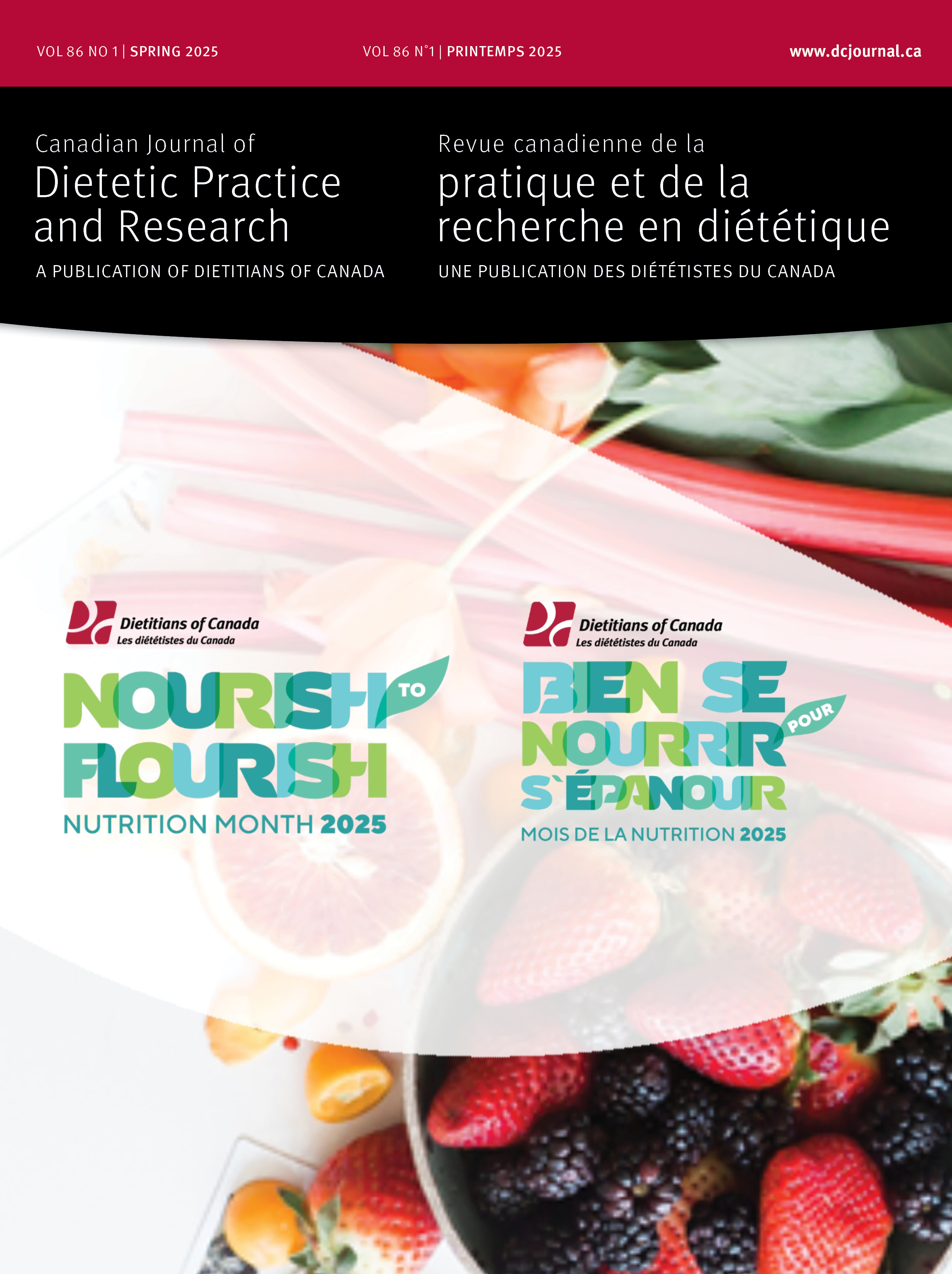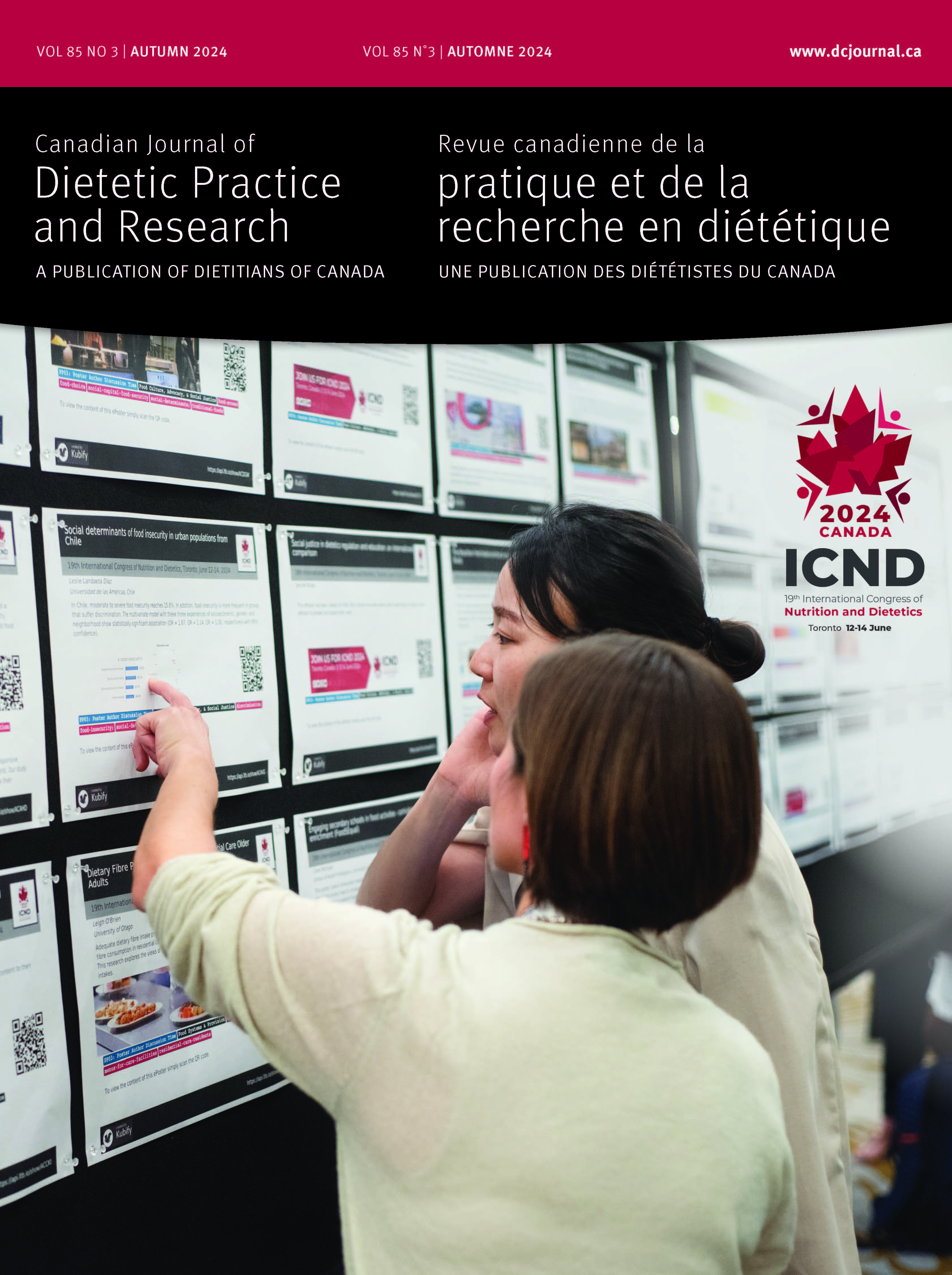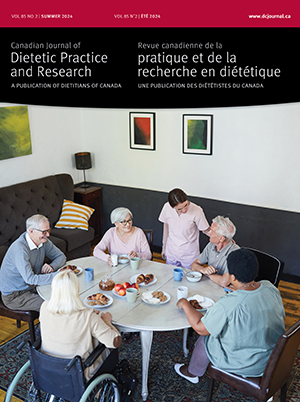Volume 68 • Number 3 • September 2007
Chair’s Message
Editor’s Message
Research
Purpose: To assess adults’ knowledge of dietary recommendations, food sources of key nutrients, food choices, and diet-disease relationships. Methods: A previously validated survey, designed to assess nutrition knowledge, was adapted for use in Prince Edward Island and mailed to a random sample of 3,500 adults (aged 18 to 74). Dillman's Total Design Method was followed and a response rate of 26.4% achieved. Mean scores and 95% confidence intervals (CIs) were calculated for the overall survey and for each section. Demographic variations were assessed by univariate analysis. Results: Of an overall possible score of 110 points, the mean score with 95% CI was 71.0 (70.1, 71.9). Respondents scored higher on the sections on dietary recommendations, food sources, and food choices than diet-disease relationships. Demographic differences existed in gender, age, education, and income. Findings suggest that adults have good general knowledge of dietary recommendations, but lack knowledge about how to make healthier food choices and the impact of diet on disease risk. Conclusion: When designing intervention strategies, dietitians should consider targeted messages to provide adults with the information they need to make healthy food choices.
Perspectives in Practice
The Media and the Message – Promoting Healthy Eating and Active Living for Diabetes Prevention was a project aimed at raising awareness of diabetes risk factors and enhancing the public's access to credible, up-to-date, healthy eating and active living messages in the media. Cross-country workshops were held to teach media strategies and key diabetes prevention messages to multidisciplinary groups of health professionals. Evaluation was integral to the project; both the process and outcomes were assessed using Health Canada's Population Health Approach. Timeline and budget were tracked. Questionnaires were created to evaluate advisory committee conference calls and to determine participants’ perceptions of the 19 workshops and resources. A pre-workshop/post-workshop and three-month follow-up questionnaire format, along with an online media-tracking tool, was used to collect outcome data and to measure changes in confidence and media behaviour. Sixty-three percent of participants (150 of 238) reported that multidisciplinary workshops were very valuable. Three-month follow-up revealed a significant increase in confidence in all media activities taught at the workshops, although this failed to translate into increased media activity. Sixty-eight percent (78 of 115) of responding participants disseminated workshop learning. Detailed evaluation revealed that multidisciplinary workshops are valued and effective in increasing confidence. However, eliciting behaviour change following a workshop remains a challenge.
Report
Purpose: A dietitian-administered, shortened form of the Apple and Agras cognitive-behavioural therapy (CBT) method was evaluated in a group setting to determine its effect on improving obese women's self-esteem and reducing binge-eating behaviours, depression, and negative body image. Methods: Participants were recruited through newspaper and radio advertisements. Respondents who met study selection criteria were randomly assigned to either a CBT group (n=13) or a delayed group (D-CBT) (n=9). The treatment was administered over six weekly sessions to the CBT group, and then twice weekly over three weeks to the D-CBT group. Two measures of bingeing behaviour (severity and frequency), three measures of mood (depression, body image, and self-esteem), and body weight were assessed. Results: The intervention did not result in any changes in body weight. There were statistically significant and clinically important changes after treatment (p<0.05) for all five measures. Binge-eating severity and frequency decreased, depression decreased, body image improved, and self-esteem improved. All changes were greater in the six-week treatment group. Conclusions: The dietitian-administered, group setting CBT program is effective for reducing binge eating and improving emotional state in obese women.
Purpose: Dietary folic acid (FA) intakes were analyzed in random samples of 302 young women (aged 18 to 34) and 337 seniors (aged 65 to 74) residing in Newfoundland and Labrador (NL). The analyses were an attempt to estimate the amount of FA they would consume solely because of mandatory fortification of foods. Methods: Secondary analysis was performed on raw data collected through single 24-hour recalls as part of a larger study. Results: The dietary FA contributed by fortified foods eaten in the specified amounts was estimated to be 136 to 148 mcg/day (226 to 247 DFE/day) for young women and 151 to 160 mcg/day (252 to 267 DFE/day) for seniors. Most of this FA was contributed to the diet by enriched white flour. Conclusions: Mandatory fortification of foods appears to have improved the total mean intake of folate by young women and seniors residing in NL.
Purpose: Consumer workshops in rural and remote locations were evaluated for their efficacy in changing participants’ selfperceived attitudes and behaviours related to nutrition labelling. Methods: Project-trained community health educators used pilot-tested workshop resources to facilitate 18 workshops across the country. Participants completed pre-workshop questionnaires to permit the identification of demographic characteristics and attitudes and behaviours related to nutrition labelling at pointof- purchase. Results: The majority of the 259 consumers who submitted questionnaires were women (81%), and aged 35 to 54 (35%); 51% reported more than a high school education and 34% had less than $25,000 as a yearly family income. Self-perceived attitudes and behaviours related to nutrition labelling differed only slightly by family income before the workshop. Workshops were rated positively (mode=4 [range 2 to 5]). Thirty-five consumers were surveyed three months after the workshop; the majority were women (89%), were aged 35 to 54 (43%), and had completed high school (51%). Self-perceived attitudes and behaviours for all respondents (n=35) had improved. Use of acquired knowledge and skills at point-of-purchase was high for all respondents (mode=4 [range 2 to 5]; five-point Likert scale). Conclusions: Providing in-person consumer workshops with pilot-tested materials in rural and remote locations had positive impacts on attitudes and behaviours related to the use of nutrition labelling.
Purpose: A new dietary zinc assessment tool (ZAT) was evaluated to determine its usefulness in estimating zinc intakes among college students. Methods: A food frequency questionnaire specifically designed for calculating average zinc intakes was administered to university students who had also completed three-day food records. Zinc intakes from the two instruments were compared. Results: Among 171 participants (38 male, 133 female) aged 20.2 ± 1.6 years (mean ± standard deviation), the two dietary assessment methods were positively correlated (r=0.33, p<0.001). The ZAT correctly identified 76% of the women who were obtaining less than the National Academy of Sciences Recommended Dietary Allowance for zinc (8 mg/day for females, 11 mg/day for males). Conclusions: This convenient tool may assist in the identification of problematic dietary patterns at an early stage. Further design modifications and expanded studies are warranted.
Purpose: Students entering university often lack knowledge about fats; whether students gain such information during four years at university is unclear. Students’ knowledge of fat in the first and fourth years was measured and compared. The effect of a nutrition course on knowledge was also examined. Methods: A total of 215 science students at a small undergraduate university completed a 15-item, closed-ended questionnaire concerning knowledge of fats in the diet. Results: Fourth-year science students have greater nutrition knowledge of fats than do first-year science students (p<0.005). Given that the majority of first-year students reside on campus and the majority of fourth-year students reside off campus, the purchasing of food and preparation of meals may explain the senior students’ greater knowledge of fat. Students who have taken a nutrition course know more about fats than do those who have not (p<0.001). Conclusions: Taking even one course in nutrition greatly increases nutrition knowledge. Universities could encourage undergraduate students to take a basic nutrition course, which should emphasize the identification and understanding of different types of dietary fats.
Recognition
OPEN ACCESS
From calipers to magnetic resonance imaging (MRI), we have come a long way in our ability to analyze body composition. Some historical milestones are a reminder that many concepts in muscle and fat metabolism, and their measurement, have stood the test of time. However, newer imaging technology has improved our understanding of population heterogeneity in body composition, and the potential health problems associated with certain body composition phenotypes. Imaging analyses, such as dual energy X-ray absorptiometry, computed tomography, and MRI, have provided detailed characterization of the type and amount of fat deposited centrally (abdominal adipose tissue), the trajectory of losses in muscle tissue (sarcopenia), and the combination of low muscle mass/high fat mass (sarcopenic obesity). The last is a new emerging health concern because the presence of these two disproportionate tissue depots may have an additive effect on increasing morbidity. Ongoing measurement of body composition is needed, and preliminary research suggests this may have important nutritional implications.










